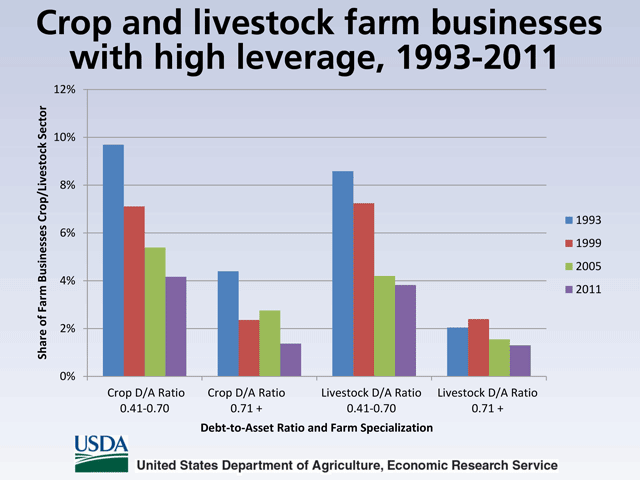by Marcia Zarley Taylor, DTN Executive Editor
HADDONFIELD, N.J. (DTN) — U.S. commercial-sized farms may have binged on debt during the last decade — investing in everything from pricey farmland to auto-steer farm equipment to jumbo-sized operating lines. But unlike heavily indebted consumers at the peak of the housing bubble, today's credit-intensive farmers are ending their investment streak in the strongest financial position in at least 20 years and maybe even rivaling the 1970s.
The question under debate by economists and farm lenders is whether that stockpile of cash and assets is capable of weathering a prolonged downturn in the farm economy or whether it's 1979 for farmers all over again.
Average debt owed by U.S. farm businesses jumped 39{0a3336b3da8cf935de4f3eb78fe29508c4b8b5ebd27d01af2d815614325d533e} between 1992 and 2011, even after adjusting for inflation, a new study by USDA's Economic Research Service (ERS) found. But despite more reliance on credit, the vast majority of farmers possess conservative debt-to-asset ratios with a huge cushion of equity should commodity prices cool and interest rates begin to tick upward. The USDA data is based on surveys of more than 20,000 farmers annually.
Real farm incomes this past decade never quite broke the all-time highs of 1973 when adjusted for inflation, said Jennifer Ifft, an ERS economist and one of the study's authors. But farm leverage peaked in the middle 1980s and has been on a downward trend ever since: The average full-time farm operator's debt-to-asset ratio hovered near 13{0a3336b3da8cf935de4f3eb78fe29508c4b8b5ebd27d01af2d815614325d533e} in 1992, but slid to 9{0a3336b3da8cf935de4f3eb78fe29508c4b8b5ebd27d01af2d815614325d533e} by 2011, the most recent data in USDA's study. That's less than half the 22{0a3336b3da8cf935de4f3eb78fe29508c4b8b5ebd27d01af2d815614325d533e} rate farmers averaged at the peak of the farm credit crisis in 1985, before years of loan write-offs and debt pay-downs began in earnest.
Even the nation's most potentially risky farm borrowers — those full-time operators with debts 40{0a3336b3da8cf935de4f3eb78fe29508c4b8b5ebd27d01af2d815614325d533e} or more of their assets — are shrinking in numbers. In 2011, only 5.3{0a3336b3da8cf935de4f3eb78fe29508c4b8b5ebd27d01af2d815614325d533e} of farm businesses held that leverage level, down from 9.5{0a3336b3da8cf935de4f3eb78fe29508c4b8b5ebd27d01af2d815614325d533e} in 1992, said Ifft. What's more, that highly leveraged category accounts for a shrinking share of total farm business debt compared to 20 years ago.
At least two potential trouble spots still exist should the farm economy take a prolonged tumble. Ifft worries most about young farmers whose numbers have shrunk drastically over the past two decades: Because they rent the bulk of the operations, young operators didn't benefit as much from the windfalls that accrued to landowners during this era. In fact, leverage levels for full-time farmers under age 35 remain as high today as they were 20 years earlier, about 19{0a3336b3da8cf935de4f3eb78fe29508c4b8b5ebd27d01af2d815614325d533e}, Ifft said.
Another potential concern is large-scale family farms — defined as those with sales in excess of $1 million. They acquired 70{0a3336b3da8cf935de4f3eb78fe29508c4b8b5ebd27d01af2d815614325d533e} more debt during this period, the largest gains of any sized operations. While they borrowed an average of $684,400 in 1992, their total debt ballooned to $1.165 million in 2011 inflation-adjusted dollars. Increasing cash rents, land purchases and machinery costs contributed to those debt loads, burdens that may be hard to shed if commodity prices and repayment capacity shrink.
READY FOR $3 CORN?
Many forecasters predict leaner farm incomes and a return to much higher interest rates in the decade ahead, both of which have implications for land values and borrowers' repayment capacity.
Allen Featherstone, a Kansas State University economist, agrees farmers are on excellent footing at the moment, but cautions not to become complacent.
“We're probably in as good a position as we've been in the last 20 years, but in some respects they were in good shape in 1979, too. Then things changed very quickly,” he said.
His analysis of 1,200 Kansas farms using a default model based on 150,000 Farm Credit loans shows only about 1.5 farms out of every 100 are at risk of default today, nearly the same as in 1979. By the early 1980s, however, interest payments had ballooned 65{0a3336b3da8cf935de4f3eb78fe29508c4b8b5ebd27d01af2d815614325d533e} just as farm incomes slid 16{0a3336b3da8cf935de4f3eb78fe29508c4b8b5ebd27d01af2d815614325d533e}. Farm repayment capacity crashed.
It doesn't take many bad loan defaults to harm a loan portfolio and send the industry's land values spinning, Featherstone said. During the worst time to be lending in the later 1970s, only 10.9{0a3336b3da8cf935de4f3eb78fe29508c4b8b5ebd27d01af2d815614325d533e} of farm real estate loans held by a major insurance company defaulted, he said. Eighty percent of the loans that defaulted were originated from 1977 to 1980.
“Sometimes we may think we're bulletproof, but the economic situation can change very quickly,” he said. “The worst thing that could happen to the crop sector is a couple of bumper crops in a row, with surpluses that drive prices down. Crop insurance adjusts annually, so that will adjust revenue protection. It makes you more vulnerable than you think.”
Other analysts believe it's hard to compare today's agriculture to 40 years ago. For one thing, 83{0a3336b3da8cf935de4f3eb78fe29508c4b8b5ebd27d01af2d815614325d533e} of real estate loans at Farm Credit Services of America now have fixed-rate terms, so interest rate hikes pose fewer threats than in 1979. About eight out of 10 farmers now carry revenue-based crop insurance, a product that's only become commonplace since 2000. On the other hand, most farmers specialize in either crops or livestock, so they aren't as diversified as their grandfathers' generation.
“While the farm crisis of the 1980s happened 30 years ago, a lot of people are still around who remember it, even if they were just young loan officers,” said Steve Gabriel, chief economist for the Farm Credit Administration, the Farm Credit System's regulator.
“What we're seeing is quite a bit of conservatism in underwriting loans. There's been pretty good discipline as far as we can tell,” Gabriel said. “We're expecting a [land value] correction of 20{0a3336b3da8cf935de4f3eb78fe29508c4b8b5ebd27d01af2d815614325d533e} to 25{0a3336b3da8cf935de4f3eb78fe29508c4b8b5ebd27d01af2d815614325d533e} over the next few years, but the system can absorb that. It won't feel good, but we can handle it.”
For a copy of the ERS report go to http://www.ers.usda.gov/…
© Copyright 2014 DTN/The Progressive Farmer. All rights reserved.
Posted with DTN Permission by Haylie Shipp


